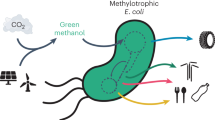Abstract
The multi-copy plasmid vector pIJ702 has been used to clone Streptomyces clavuligerus chromosomal DNA fragments into a clavulanic acid non-producing mutant strain. Two DNA segments, which restored the ability to synthesise clavulanic acid, were shown to overlap one another and share a common sequence of about 2 kb. A preliminary restriction map of the region of the chromosome involved has been constructed.
This is a preview of subscription content, access via your institution
Access options
Subscribe to this journal
Receive 12 print issues and online access
$209.00 per year
only $17.42 per issue
Buy this article
- Purchase on Springer Link
- Instant access to full article PDF
Prices may be subject to local taxes which are calculated during checkout
Similar content being viewed by others
References
Reading, C. and Cole, M. 1977. Clavulanic acid: A beta-lactamase-inhibiting beta-lactam From Streptomyces clavuligerus . Antimicrob. Agents Chemother. 11: 852–857.
Chater, K.F., Hopwood, D.A., Keiser, T. and Thompson, C. J. 1982. Gene cloning in Streptomyces . Curr. Top. Microbiol. Immunol. 96: 69–95.
Hopwood, D.A. and Chater, K.F. 1982. Cloning in Streptomyces: Systems and strategies, p. 119–145. In: Genetic Engineering, Setlow, J.K. and Hollaender, A. (eds.), vol. 4, Plenum Press, New York.
Katz, E., Thompson, C.J., and Hopwood, D.A. 1983. Cloning arid expression of the tyrosinase geric from Streptomyces antibioticus in Streptomyces lividans . J. Gen. Microbiol. 129: 2703–2714.
Thompson, C.J., Ward, J.M., and Hopwood, D.A. 1982. Cloning of antibiotic resistance and nutritional genes in Streptomyces . J. Bacteriol. 151: 668–677.
Bird, A.E., Bellis, J.M., and Gasson, B.C. 1982. Spectrophotometric assay of clavulamt acid by reaction with imidazole. Analyst 107: 1241–1245.
Foulston, M. and Reading, C. 1982. Assay of amoxicillin and clavulanic acid, the components of Augmentin, in biological fluids with high-performance liquid chromatography. Antimicrob. Agents Chemother. 22: 753–762.
Hopwood, D.A. 1983. Actinomycete genetics and antibiotic production, p 1–24. In: Biochemistry and Genetic Regulation of Commercially Important Antibiotics. Vining, L.C. (ed.), Addison-Wesley, Reading, MA.
Hopwood, D.A., Bibb, M.J., Bruton, C.J., Chater, K.F., Feitelson, J.S., and Gil, J.A. 1983. Cloning Streptomyces genes for antibiotic production. Trends in Biotechnology 1: 42–48.
Martin, J.F. and Gil, J.A. 1984. Cloning and expression of antibiotic production genes. Biotechnology 2: 63–72.
Feitelson, J.S. and Hopwood, D.A. 1983. Cloning of a Streptomyces gene for an o-methyltransfcrase involved in antibiotic biosynthesis. Molec. Gen. Genet. 190: 394–398.
Author information
Authors and Affiliations
Rights and permissions
About this article
Cite this article
Bailey, C., Butler, M., Normansell, I. et al. Cloning A Streptomyces clavuligerus Genetic Locus Involved in Clavulanic Acid Biosynthesis. Nat Biotechnol 2, 808–811 (1984). https://doi.org/10.1038/nbt0984-808
Received:
Accepted:
Issue Date:
DOI: https://doi.org/10.1038/nbt0984-808



